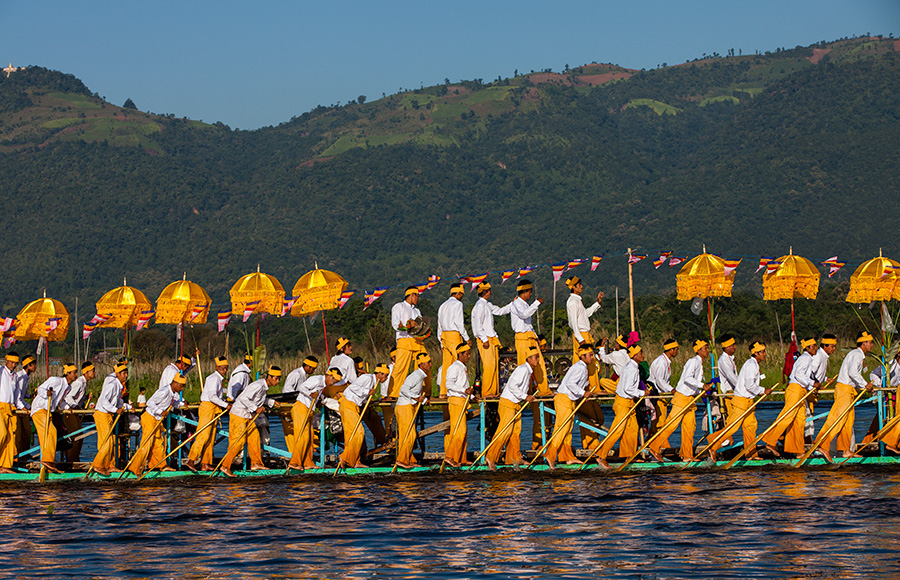
Also see: Our photography tour to Myanmar in October
It was a festival morning. About a hundred or so boats had gathered as a long thick band in the middle of the lake, waiting for the procession to pass by. A hundred boats would seem like a lot, but against the scale of the lake that is spread more than a hundred sq kilometers, the boats did not make up to much. As we approached the place of all the action, I heard the sound of bells at a distance to my left, somewhere in the vicinity of a monastery in Lin Kin Village. The procession was about to begin. Today’s procession was to take four Buddha idols of Phaung Daw Oo pagoda from Lin Kin to Nyaung Shwe town.

Inle Lake sets out for this festive celebrations every year in October-November months. The procession of Buddha images begins from their temple of residence–the Phaung Daw Oo pagoda–and crisscrosses every village in the lake taking eighteen days before returning home. Everyday, as Buddha moves from village to village, entire community gathers together to escort the parade with great fanfare. Every village decorates a long boat that will be part of the ‘boatcade‘. Each boat, carrying more than a hundred people rowing in sync to music, escort a gilded boat carrying the four golden Buddha images slowly glides over the lake. But one Buddha image continues to stay out of the festival.

Also see: my photography tour to Myanmar.
It was a pleasant October evening, but an unusual moment when I arrived in Mandalay. Our boat docked after a long journey upstream on Ayeyarwady, throwing us immediately into chaos that we weren’t prepared for. The road from jetty to the city was clogged with people in a celebratory mood. Loud speakers–giant black boxes decked on mini-trucks–blared loud and shrieking music on a road filled with revelers dancing wildly. Chaos, crowds and cacophony had conquered the road in a way I had never seen anywhere during my journeys across Myanmar.

Sunset hour at U-Bein Bridge, Amarapura, Mandalay.
In the last leg of our week-long trip in Myanmar that had taken us through the depths of a spiritual, graceful and congenial country, we had suddenly landed into an unexpected contrast. It was the last day of Durga Puja, and much of the Indian-descents in the city had gathered by the riverside for a procession and idol immersion. We got off the car, which we had barely boarded after alighting the boat that had ferried us from Bagan, and walked into the gathered crowd. Cameras strapped around our neck, we stood out as tourists in the completely-local crowd, and caught the attention of a few revelers in no time.
Living just a few kilometers away from the bustling settlements and well-worn paths around Myanmar’s Inle Lake are villages that still live off the grid. A strong sense of community has helped them adapt to the modern world and continue to subsist in a fast-changing country.
My connecting-the-dots from the popular Inle Lake to Shan Hills started as I wandered the streets in search of things to do in the area. A travel-agency boldly announced trekking options, but a smaller sign that talked about a ‘home-stay’ got me interested. The deal was made in minutes and my plans for the next two days was set. I was heading to the hills next morning and stay in a village inhabited PaO people, one of the many indigenous communities in Shan state.

Shan Hills, as seen from Inle Lake.
We began early next morning. It was a pleasant post-monsoon dawn when a thin layer of clouds kept the air crisp – perfect for the long walk ahead. We quickly put behind us the line of restaurants and lodges on the edge of Inle Lake and hiked up the green hills to the east. The path took us up the gentle slopes through the clearings, past wooded sections, occasional opening into corn fields and subsequently through cheerful grassland slopes with a scattering of colourful flowers. The few hamlets we saw along the way were small, with only a handful of houses located adjacent to the fields.




